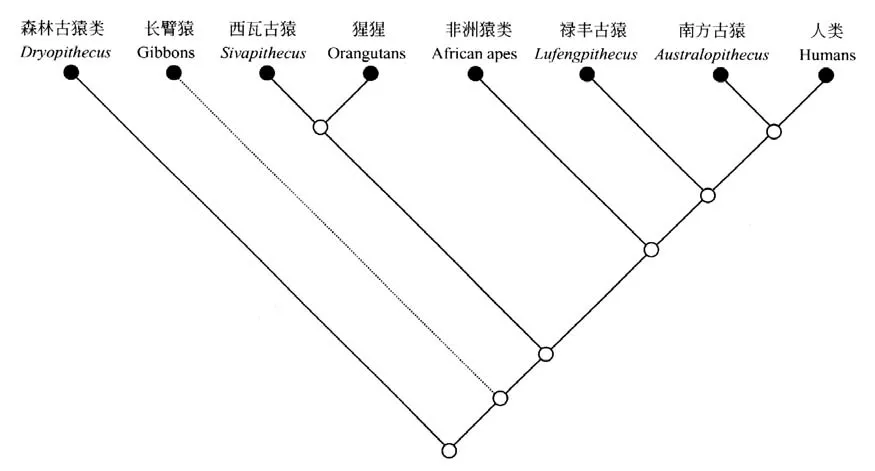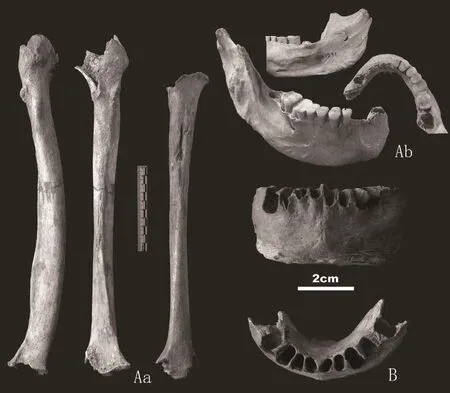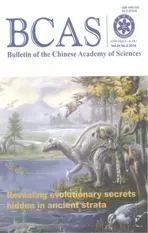In Search of the Ancestors of Chinese People
2010-12-30GAOXingandWANGChunxue
GAO Xing* and WANG Chunxue
Institute of Vertebrate Paleontology and Paleoanthropology, CAS, Beijing 100044, China
Presently, the research on the origin of Chinese ancestors focuses on two issues,namely the origin of the first human populations in Asia and the origin of modern Chinese people.Up till now, all the fossils of Australopithecus and Homo habilis, the earliest two stages of human evolution, are from Africa,and no human fossil earlier than 2.0 million years ago is available outside of this continent.With this understanding, the international paleoanthropological community at large believes that Africa cradled the remote ancestors of humankind.As for the origin of modern human beings, particularly modern Chinese, long-lasting conflicts exist between two schools of ideas,one of which advocates Africa as the exclusive cradleland, while the other argues that actually multiple evolutional centers coexisted in the process of human evolution, where continuous evolution occurred.
Origins of the earliest humans in China and Asia
Today the earliest time remains unknown when human beings appeared in China or even Asia.Some scholars believe that southern Asia, where anthropoids dated to 6.0 to 8.0 million years ago were unearthed, could be a cradleland of early humans.Recently,some scholars furthered their studies into the fossils discovered from sites in Lufeng, Yuanmou and Kaiyuan counties in Yunnan, China, and advanced that some characters of the fossils found in Lufeng are similar in some ways to those from south Africa,and closer to the latter concerning configuration compared to other species of anthropoids (Xu & Lu, 2008:P172).For this reason, Lufengpithecus lufengensis is treated as an early branch of the hominid family, a transitional ring between apes and hominids earlier than Australopithecus, and therefore might be the remote ancestor to human species later emerging on the lands of what is now China (Fig.1).Opponent scholars argued that, however, the erain which Lufengpithecus lufengensis lived overlapped with that of the early species from Africa, and on the other hand, the characteristics of their configuration do not indicate a forefather-offspring relationship between them (Wu, 1999).More importantly, no material from indubitable Australopithecus and Homo habilis is found to date within the territory of China or even anywhere outside of Africa.In view of this, Africa is currently believed by most scholars to be the sole origin of remote ancestors of human beings.

Fig.1 The phylogeny given by the scholars who advocate that Lufengpithecus lufengensis is an early member of hominidae.(Xu & Lu, 2008: P171).
Sources and evolution of Homo erectus in China
As indicated by fossil and archeological evidence, Homo erectus had been living on the lands of China since the early stage of the Early Pleistocene.Up to now,paleoanthropologists have unearthed fossils of Homo erectus or suspected Homo erectus from numerous sites, like the Shangnabang Site in Yuanmou, Yunnan; the Longgupo Site in Wushan, Chongqing; the Longgudong Site in Jianshi, Hubei;the Gongwangling Site in Lantian,Shaannxi and the Xuetangliangzi Site in Yunxian, Hubei.Besides,cultural relics are also found in some localities, including the Renzidong Site in Fanchang, Anhui, the Xihoudu Site in Ruicheng, Shanxi, and the Nihewan Site in Yangyuan, Hebei.The Early Pleistocene cultural remains found in Nihewan Basin in Yangyuan,Hebei, dated back to 2.0 to 1.6 million years ago, yield precious materials to understand the survival and spread of early humans in China and Northeastern Asia.About these early populations, most scholars advocate that they were the offspring of Homo habilis who moved there from Africa about 2.0 million years ago.Some scholars, however, argue that Homo erectus had originated indigenously and was a hominid species unique to East Asia.The latter opinion is not accepted widely, in that it lacks support from local fossil or cultural evidence dating to 6.0 to 2.0 million years ago.Some scholars pin their hope on the discovery of new materials through further investigations and excavations to fill in this gap in early human evolution of East Asia, and thus significantly revise the theory of human origins.
Another important factor holding back the research in early human origins and evolution in China is the underdeveloped chronology.Fortunately some breakthroughs were achieved in recent years.Just take the case of Zhoukoudian Locality 1 as an example.In the 20thcentury, scholars employed different methods, including fissiontrack dating, disequilibrium uranium series method, paleo-geomagnetic method and electron spin resonance to date this site, and based on the largescale multi-disciplinary investigation a rough chronological framework was established.In 2009 a Sino-US joint research team reported in Nature a new dating result based on cosmogenic26Al/10Be burial dating technique.The 7thto 10thlayers of the strata in the cave, asserted the authors, could be about 0.77±0.08 million years old(Shen, et al., 2009), more than 200,000 years older than formerly believed.The new result has attracted attention from the international academic community and stirred widespread controversy and discussions, inspiring further research in related issues in this field.Soon after that, systematic excavation resumed in this site after a long suspension, and important new evidence is emerging from the caves there.
Origin of modern Chinese
Since over two decades ago,two theories about the origin of modern human beings have been standing in sharp opposition with each other within the international paleo-anthropological community(Wolpoff, Wu & Thorne, 1984).Based on mitochondria DNA analysis,some Western scholars advocate the sole origin of Africa, stating that modern human beings from across the world are all descendants of the human populations living in Africa about 200,000 to 150,000 years ago.According to this theory, East Asian Homo erectus represented by Peking Man were extinct branches in the evolution tree and did not transfer their genes down to modern humans.Part of Chinese molecular biologists support this theory via their research on the Y chromosome of East Asian people, putting forward that the direct ancestor of modern Chinese people moved into this area from Africa about 60,000 to 50,000 years ago by way of West Asia, South Asia, Southeastern Asia, and then traveled from the south to the north.Other scholars hold a different opinion.They argue that modern Chinese people are the result from a continuous evolution sourcing from multiple areas.According to this theory, the direct ancestors of modern human all over the world were the indigenous early hominids(archaic Homo sapiens or even Homo erectus) who evolved continuously into modern humankind.During their evolution, a small quantity of genetic exchanges occurred between them and foreign populations.
The key issue in the debate between the two schools of theories is whether or not the evolution of early humans in Asia and Europe had been disrupted.Since the beginning of the 20thcentury, Homo sapiens fossils of different ages have been found in Dali,Jinniushan, Maba, Dingcun, Xujiayao,Changyang, Liujiang, Shandingdong and Ziyang sites, which show that the evolution of early human beings in China had never been interrupted.Very lately, a piece of incomplete fossilized mandible was unearthed from the Mulanshan site in Chongzuo City, Guangxi.This specimen had some initial anatomic characteristics of modern human, appearing transitional characters from early human species to modern human (b in Fig.2).Judging from stratigraphic correlation and U-series dating results, along with the components of the accompanying mammal fauna, its age should be about 110,000 years old (Jin, et al., 2009).Falling in the early Late Pleistocene, a critical period in human evolution, it has important implications for research in the origin of modern human and the corresponding environmental background.In 2003, some fossils from early modern human were found at the Tianyuandong site at Zhoukoudian (a1 and a2 in Fig.2).Dating back to 42,000 to 38,500 years ago, this mark the earliest remains of modern human to date found in eastern Eurasia.Most of the characteristics of this specimen were in consistence with those of modern human, but with few characters close to those of the late stage of archaic Homo sapiens,indicating possible genetic flow from the West and the South (Shang, et al.,2007).This fossil evidence sufficiently demonstrates that the evolution from Chinese or even East Asian Homo erectus to late Homo sapiens was continuous: Human fossils of different ages share a series of common characteristics, with mosaic settings occurring between Homo erectus and Homo sapiens.Meanwhile, a small number of properties emerging in several specific fossils resemble to those of contemporary Western species and differ from those of their local cousins.This is believed to be a result from genetic exchanges.Based on this fact, CAS Member Prof.WU Xinzhi proposed the “Continuity with Hybridization” model (Wolpoff, Wu& Thorne, 1984) of modern human origins in East Asia, concluding that the evolution of early human beings in China or even East Asia was continuous with occasions of cross breeding.Many anthropologists in the West also hold similar stands concerning this issue.

Fig.2 Fossils of early humans.
Archeology also contributed significantly to the research on the origin of modern Chinese people over the recent years.From the view of technological and cultural development of early humans, the populations in China or even East Asia manifested a consistency and stability in terms of behavior and technology,from the whole Paleolithic throughout the early Neolithic, forming an overall pattern dominated by inheritance rather than replacement.This unique evolutional pattern featuring gradual changes had never been interrupted or replaced.About 800,000 years ago, remains of stone tool industry as sophisticated as contemporary Acheulean technology in the West,like handaxes, appeared at a few sites in south and middle China; moreover,about 30,000 years ago, stone blade technology, which showed some cultural characteristics that could also be found in its Western counterparts living in the Upper Paleolithic,emerged in north China.These cultural characters, however, had just risen sporadically and meteorically, leaving little inf l uence on the local mainstream culture.In acknowledge of this,scholars proposed that the mainstream populations in Pleistocene China or even East Asia had been surviving and multiplying continuously, and their culture had robust vitality, being handing down from generation to generation.“Alien” cultures, which were occasionally brought in by small quantities of foreign populations,briefly disappeared in the face of the dominance of mainstream culture.An important reason might be the local populations had developed a complete set of survival strategies adaptable to local ecological conditions during their long-term battle with nature to survive.The key of this set of strategies, which is named “comprehensive behavior model (Gao & Pei, 2006),” is to make the most of the conditions available locally, to keep a harmonious and friendly relationship with the local survival environment.They restricted their own exploitation of local natural resources to a mild extent by moving frequently, and meanwhile modified and assimilated foreign cultures that occasionally penetrated in.
So far, two central issues in this field, the origin of the earliest human species and the origin of modern Chinese people are still under dispute and study.To achieve breakthroughs in this major area, which greatly concerns the international academic community,more valuable and convincing new materials are urgently needed, so are an upgraded and improved S&T platform, to yield crucial scientific information in fossils and related materials.Therefore, more intensive funding and policy support, including polices that would help breaking the blockage and monopoly of local fossil and ancient cultural resources, and fostering of related disciplines are of critical importance.
Gao, X.& Pei, S.W., 2006.An archaeological interpretation of ancient human lithic technology and adaptive strategies in China.Quaternary Sciences, (4): 506–513.(In Chinese)
Jin, C.Z., Pan W.S., & Zhang Y.Q., et al., 2009.The Homo sapiens cave hominin site of Mulan Mountain, Jiangzhou District,Chongzuo, Guangxi with emphasis on its age.Chinese Science Bulletin, 54(19): 2848–2856.(In Chinese)
Shang H., et al., 2007.An early modern human from Tianyuan Cave, Zhoukoudian, China.Proc Natl Acad Sci USA, 104(16):6573–6578.
Shen, G.J., Gao, X., Gao, B., et al., 2009.Age of Zhoukoudian Homo erectus determined with26Al /10Be burial dating.Nature, (458):198–200.
Wolpoff, M.H., Wu, X., Thorne, A., 1984.Modern Homo sapiens origins: A general theory of hominid evolution involving the fossil evidence from East Asia.In: Smith F.H.& Spencer F.The origins of modern humans.New York: Alan F Liss Inc, 411–483.
Wu, X.Z., 1999.Chinese human Paleontological study in 20th Century and prospects.Acta Anthropol Sin, 18(3): 165–175.(In Chinese)
Xu, Q.H.& Lu, Q.W., 2008.Lufengpithecus lufengensis—an early member of hominidae.Science Press.(In Chinese)
杂志排行
Bulletin of the Chinese Academy of Sciences的其它文章
- Dinosaurs of a Feather
- The Origin and Diversification of Osteichthyans and Sarcopterygians:Rare Chinese Fossil Findings Advance Research on Key Issues of Evolution
- Amazing Reptile Fossils from the Marine Triassic of China
- Ongoing Research Projects at IVPP (A Selection)
- Advances in Vertebrate Paleontology and Paleoanthropology in China
- Recent Advances in Meso-Cenozoic Fish Research
